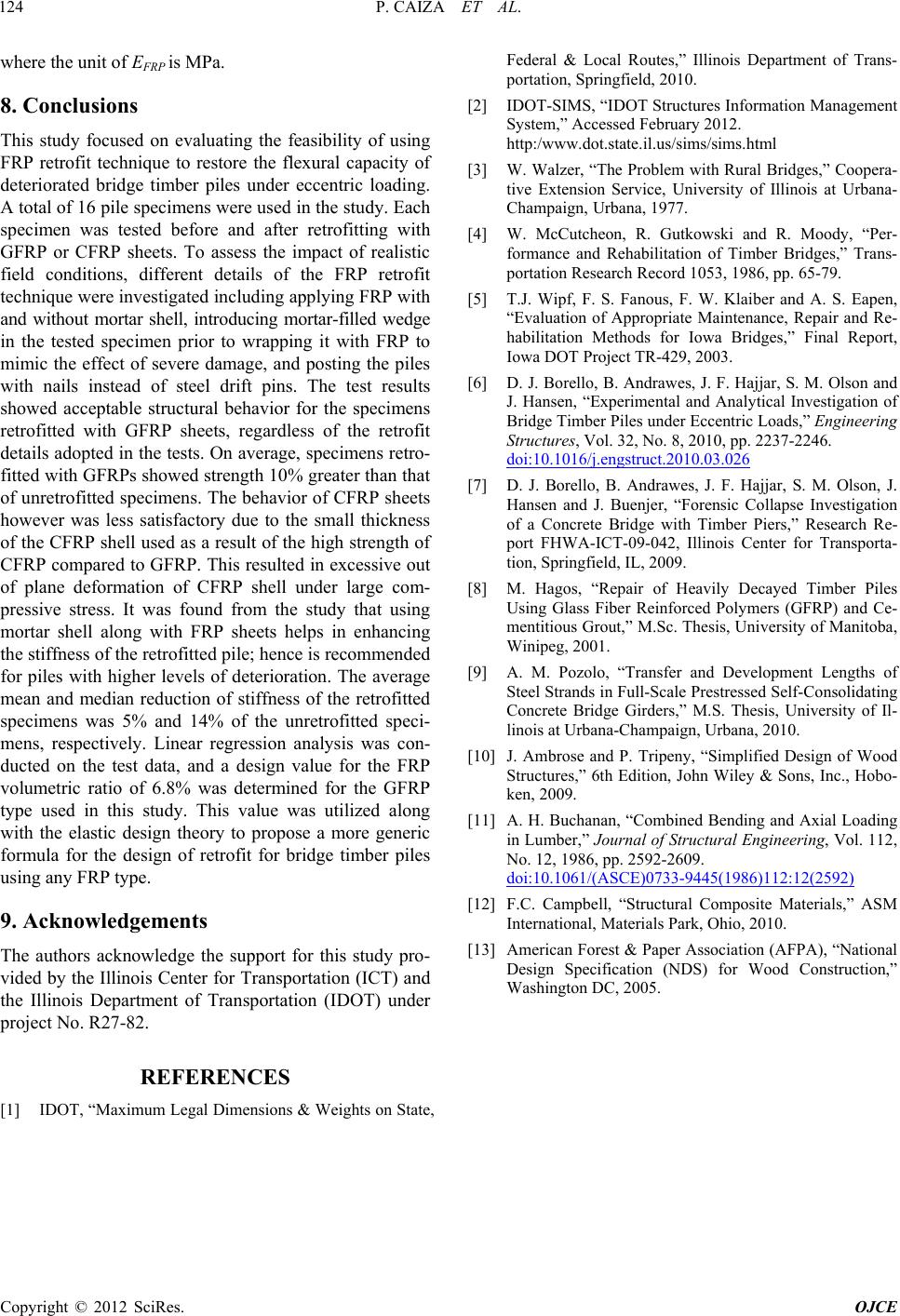
P. CAIZA ET AL.
124
where the unit of EFRP is MPa.
8. Conclusions
This study focused on evaluating the feasibility of using
FRP retrofit technique to restore the flexural capacity of
deteriorated bridge timber piles under eccentric loading.
A total of 16 pile specimens were used in the study. Each
specimen was tested before and after retrofitting with
GFRP or CFRP sheets. To assess the impact of realistic
field conditions, different details of the FRP retrofit
technique were investigated including applying FRP with
and without mortar shell, introducing mortar-filled wedge
in the tested specimen prior to wrapping it with FRP to
mimic the effect of severe damage, and posting the piles
with nails instead of steel drift pins. The test results
showed acceptable structural behavior for the specimens
retrofitted with GFRP sheets, regardless of the retrofit
details adopted in the tests. On average, specimens retro-
fitted with GFRPs showed strength 10% greater than that
of unretrofitted specimens. The behavior of CFRP sheets
however was less satisfactory due to the small thickness
of the CFRP shell used as a result of the high strength of
CFRP compared to GFRP. This resulted in excessive out
of plane deformation of CFRP shell under large com-
pressive stress. It was found from the study that using
mortar shell along with FRP sheets helps in enhancing
the stiffness of the retrofitted pile; hence is recommended
for piles with higher levels of deterioration. The average
mean and median reduction of stiffness of the retrofitted
specimens was 5% and 14% of the unretrofitted speci-
mens, respectively. Linear regression analysis was con-
ducted on the test data, and a design value for the FRP
volumetric ratio of 6.8% was determined for the GFRP
type used in this study. This value was utilized along
with the elastic design theory to propose a more generic
formula for the design of retrofit for bridge timber piles
using any FRP type.
9. Acknowledgements
The authors acknowledge the support for this study pro-
vided by the Illinois Center for Transportation (ICT) and
the Illinois Department of Transportation (IDOT) under
project No. R27-82.
REFERENCES
[1] IDOT, “Maximum Legal Dimensions & Weights on State,
Federal & Local Routes,” Illinois Department of Trans-
portation, Springfield, 2010.
[2] IDOT-SIMS, “IDOT Structures Information Management
System,” Accessed February 2012.
http:/www.dot.state.il.us/sims/sims.html
[3] W. Walzer, “The Problem with Rural Bridges,” Coopera-
tive Extension Service, University of Illinois at Urbana-
Champaign, Urbana, 1977.
[4] W. McCutcheon, R. Gutkowski and R. Moody, “Per-
formance and Rehabilitation of Timber Bridges,” Trans-
portation Research Record 1053, 1986, pp. 65-79.
[5] T.J. Wipf, F. S. Fanous, F. W. Klaiber and A. S. Eapen,
“Evaluation of Appropriate Maintenance, Repair and Re-
habilitation Methods for Iowa Bridges,” Final Report,
Iowa DOT Project TR-429, 2003.
[6] D. J. Borello, B. Andrawes, J. F. Hajjar, S. M. Olson and
J. Hansen, “Experimental and Analytical Investigation of
Bridge Timber Piles under Eccentric Loads,” Engineering
Structures, Vol. 32, No. 8, 2010, pp. 2237-2246.
doi:10.1016/j.engstruct.2010.03.026
[7] D. J. Borello, B. Andrawes, J. F. Hajjar, S. M. Olson, J.
Hansen and J. Buenjer, “Forensic Collapse Investigation
of a Concrete Bridge with Timber Piers,” Research Re-
port FHWA-ICT-09-042, Illinois Center for Transporta-
tion, Springfield, IL, 2009.
[8] M. Hagos, “Repair of Heavily Decayed Timber Piles
Using Glass Fiber Reinforced Polymers (GFRP) and Ce-
mentitious Grout,” M.Sc. Thesis, University of Manitoba,
Winipeg, 2001.
[9] A. M. Pozolo, “Transfer and Development Lengths of
Steel Strands in Full-Scale Prestressed Self-Consolidating
Concrete Bridge Girders,” M.S. Thesis, University of Il-
linois at Urbana-Champaign, Urbana, 2010.
[10] J. Ambrose and P. Tripeny, “Simplified Design of Wood
Structures,” 6th Edition, John Wiley & Sons, Inc., Hobo-
ken, 2009.
[11] A. H. Buchanan, “Combined Bending and Axial Loading
in Lumber,” Journal of Structural Engineering, Vol. 112,
No. 12, 1986, pp. 2592-2609.
doi:10.1061/(ASCE)0733-9445(1986)112:12(2592)
[12] F.C. Campbell, “Structural Composite Materials,” ASM
International, Materials Park, Ohio, 2010.
[13] American Forest & Paper Association (AFPA), “National
Design Specification (NDS) for Wood Construction,”
Washington DC, 2005.
Copyright © 2012 SciRes. OJCE